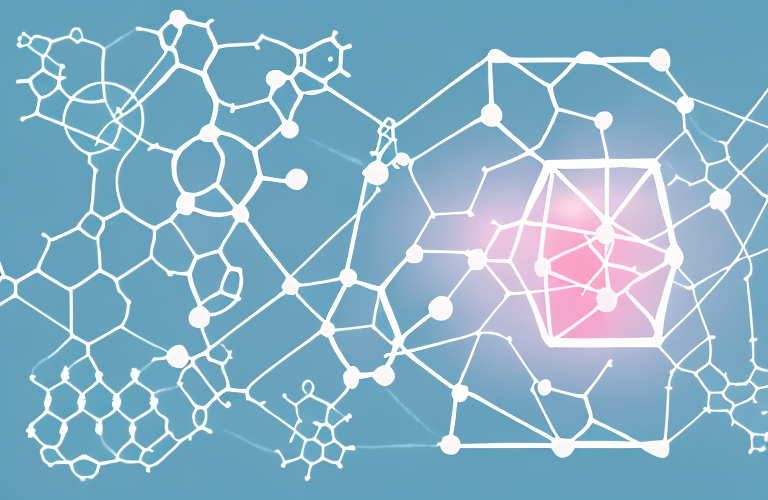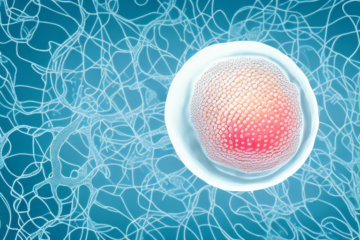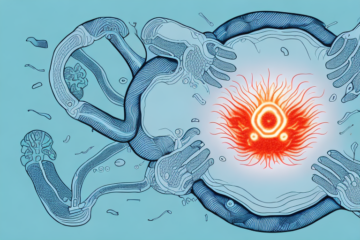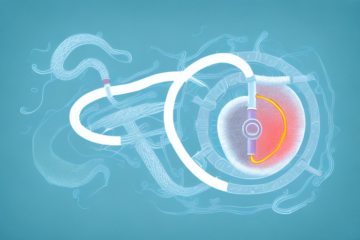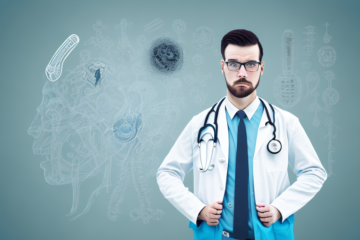Estrogen is a hormone produced mainly by the ovaries in women, although it is also present in men to a smaller extent. It plays a critical role in the development of female sexual characteristics, including breast growth, menstrual cycles, and pubic hair growth.
Understanding Estrogen: Definition and Function
Estrogen is a hormone that belongs to a group of female sex hormones called the “gonadotropins,” which are responsible for regulating the menstrual cycle and reproduction. Estrogen’s primary function is to promote the growth and overall health of female reproductive organs, including the uterus, fallopian tubes, and vagina. It is also involved in the development of secondary sexual characteristics, such as breast size and body fat distribution.
Aside from its role in reproductive health, estrogen also plays a crucial role in maintaining bone density and cardiovascular health. It helps to prevent bone loss and reduce the risk of osteoporosis in women. Estrogen also helps to maintain healthy cholesterol levels and blood vessel function, which can reduce the risk of heart disease and stroke. However, too much estrogen can also have negative effects, such as an increased risk of breast cancer. It is important to maintain a healthy balance of estrogen in the body through proper diet, exercise, and medical treatment when necessary.
Types of Estrogen: Estradiol, Estrone, and Estriol
There are three types of estrogen produced by the body: estradiol, estrone, and estriol. Estradiol is the most potent and abundant form of estrogen in women of reproductive age, while estrone is the primary estrogen during menopause. Estriol is produced in the largest amounts during pregnancy to support fetal growth and development.
Estradiol is synthesized primarily in the ovaries, but also in the adrenal glands and adipose tissue. It plays a crucial role in the development and maintenance of female reproductive tissues, as well as bone health and cardiovascular function.
Estrone is produced in the ovaries, adrenal glands, and adipose tissue. It is the only estrogen that is produced in significant amounts after menopause. Elevated levels of estrone have been linked to an increased risk of breast cancer.
The Role of Estrogen in the Female Reproductive System
Estrogen plays a crucial role in the female reproductive system, controlling the menstrual cycle and ensuring proper ovulation. It promotes the thickening and shedding of the endometrium, or the lining of the uterus, which is necessary for the regular menstrual cycle. During pregnancy, estrogen helps maintain the uterine lining and regulates fetal growth and development.
Aside from its reproductive functions, estrogen also plays a role in maintaining bone health. It helps to regulate bone growth and turnover, and low levels of estrogen can lead to bone loss and an increased risk of osteoporosis. This is why postmenopausal women, who experience a decline in estrogen levels, are at a higher risk for developing osteoporosis.
Estrogen also affects the brain and nervous system. It has been shown to improve cognitive function and memory, and may have a protective effect against neurodegenerative diseases such as Alzheimer’s. However, high levels of estrogen have been linked to an increased risk of certain types of cancer, such as breast and ovarian cancer, so it is important to maintain a healthy balance of estrogen in the body.
The Effects of Estrogen on Male Health
Although estrogen is a hormone primarily associated with female health, it is also present in men at lower levels. In men, estrogen helps regulate bone density, sexual function, and other aspects of overall health. However, high levels of estrogen in males can lead to adverse effects on male sexual health, including erectile dysfunction and reduced sperm count.
Recent studies have also shown that estrogen may play a role in the development of prostate cancer in men. While the exact mechanism is not yet fully understood, researchers believe that high levels of estrogen may stimulate the growth of prostate cancer cells. This highlights the importance of monitoring estrogen levels in men, especially those with a family history of prostate cancer.
On the other hand, low levels of estrogen in men can also have negative effects on their health. Studies have linked low estrogen levels to an increased risk of osteoporosis, a condition that weakens bones and makes them more prone to fractures. This is because estrogen helps regulate bone density, and a deficiency can lead to bone loss and increased risk of fractures.
Hormonal Imbalance: Causes and Symptoms of High or Low Estrogen Levels
Estrogen levels can fluctuate throughout a woman’s reproductive years due to medical conditions, medications, and lifestyle factors. Symptoms of high or low estrogen levels can include irregular periods, weight gain, hot flashes, sweating, and mood swings. In men, symptoms of hormonal imbalance can include breast enlargement, loss of libido, and erectile dysfunction.
One of the medical conditions that can cause hormonal imbalance is polycystic ovary syndrome (PCOS), which affects up to 10% of women of reproductive age. PCOS can cause high levels of androgens, which are male hormones, and lead to symptoms such as acne, excess hair growth, and infertility.
In addition to medical conditions, certain medications can also affect estrogen levels. For example, hormonal birth control can lower estrogen levels, while hormone replacement therapy can increase them. Lifestyle factors such as stress, lack of exercise, and poor diet can also contribute to hormonal imbalances.
Health Risks Associated with Low Estrogen Levels in Women
Low levels of estrogen can increase the risk of osteoporosis, as estrogen helps regulate bone density. Women experiencing premature menopause or those who have had their ovaries removed are at risk of low estrogen levels and should discuss hormone replacement therapy with their healthcare provider.
In addition to osteoporosis, low estrogen levels in women can also lead to vaginal dryness, which can cause discomfort during sexual intercourse and increase the risk of vaginal infections. Estrogen helps keep the vaginal lining healthy and lubricated, so women with low estrogen levels may benefit from using vaginal moisturizers or estrogen creams. It is important for women to discuss any symptoms of low estrogen levels with their healthcare provider to determine the best course of treatment.
The Connection Between Estrogen and Breast Cancer
Estrogen plays a complex role in the development of breast cancer. High levels of estrogen have been linked to an increased risk of breast cancer, while low levels of estrogen have been associated with a decreased risk. Women with a family history of breast cancer should discuss their risk factors with their healthcare provider and consider regular screening and testing.
It is important to note that estrogen is not the only factor that contributes to the development of breast cancer. Other factors, such as age, genetics, and lifestyle choices, also play a role. However, understanding the relationship between estrogen and breast cancer can help women make informed decisions about their health.
There are several ways to reduce the risk of breast cancer, including maintaining a healthy weight, exercising regularly, limiting alcohol consumption, and avoiding hormone replacement therapy. Women who are at high risk of developing breast cancer may also consider preventive measures, such as taking medication or undergoing surgery.
Menopause and Estrogen: How Hormone Replacement Therapy Works
Hormone replacement therapy (HRT) involves replacing the estrogen that the body no longer produces during menopause. HRT can alleviate symptoms such as hot flashes, vaginal dryness, and mood changes. However, it can also increase the risk of certain conditions, such as blood clots and breast cancer, and should be discussed with a healthcare provider.
It is important to note that not all women are candidates for HRT. Women who have a history of breast cancer, blood clots, or stroke may not be able to safely use HRT. Additionally, women who have a family history of these conditions may need to be cautious when considering HRT. Alternative treatments, such as lifestyle changes and non-hormonal medications, may be recommended for these women.
Natural Ways to Boost Your Estrogen Levels
There are natural ways to boost estrogen levels, such as maintaining a healthy weight and eating a balanced diet rich in fruits, vegetables, and whole grains. Soy products, flax seeds, and other sources of phytoestrogens can also help increase estrogen levels in some women.
In addition to dietary changes, regular exercise can also help boost estrogen levels. Studies have shown that women who engage in regular physical activity have higher levels of estrogen compared to those who are sedentary. However, it’s important to note that excessive exercise can have the opposite effect and lower estrogen levels. So, it’s important to find a balance and engage in moderate exercise for optimal estrogen levels.
Foods to Add to Your Diet to Increase Estrogen Production
Eating foods that contain high levels of phytoestrogens, such as soybeans, chickpeas, and lentils, can help support estrogen production. Other foods, including berries, leafy greens, and cruciferous vegetables, can also help support overall reproductive health and hormone balance.
In addition to these foods, incorporating flaxseeds into your diet can also help increase estrogen levels. Flaxseeds contain lignans, which are compounds that can be converted into phytoestrogens in the body. Adding flaxseeds to your smoothies, oatmeal, or salads can be an easy way to boost your estrogen levels naturally.
Understanding the Link Between Estrogen and Bone Health
Estrogen plays a crucial role in regulating bone density, and low levels can increase the risk of osteoporosis, particularly in women. Exercise, a healthy diet, and calcium and vitamin D supplementation can help support bone health and reduce the risk of fractures and other complications associated with osteoporosis.
It is important to note that certain medications and medical conditions can also affect bone health. For example, long-term use of corticosteroids can lead to bone loss, and conditions such as hyperthyroidism and inflammatory bowel disease can also increase the risk of osteoporosis. It is important to discuss any concerns about bone health with a healthcare provider and to undergo regular bone density screenings, especially for women over the age of 65 or those with risk factors for osteoporosis.
The Effects of Environmental Toxins on Your Body’s Estrogen Levels
Environmental toxins, including pesticides and certain plastics, can disrupt estrogen levels in the body and increase the risk of hormonal imbalance. Reducing exposure to these toxins by choosing organic produce and avoiding plastic packaging can help protect overall health and hormone balance.
Studies have shown that exposure to environmental toxins can also lead to reproductive issues, such as infertility and miscarriage. This is because these toxins can interfere with the development and function of reproductive organs. It is important to be aware of the potential risks and take steps to minimize exposure, such as using natural cleaning products and avoiding products with synthetic fragrances.
How to Test for Hormonal Imbalances in Men and Women
Your healthcare provider can conduct blood tests to measure hormone levels and identify imbalances. Depending on the results, they may recommend lifestyle changes, medications, or hormone replacement therapy to restore balance and improve overall health.
It is important to note that hormonal imbalances can have a significant impact on mental health as well. Symptoms such as anxiety, depression, and mood swings may be related to hormonal imbalances and should be discussed with a healthcare provider.
In addition to blood tests, other diagnostic tools such as imaging studies and physical exams may be used to identify hormonal imbalances. It is important to work closely with a healthcare provider to determine the best course of treatment for any identified imbalances.
Managing Hormone-Related Health Conditions with the Help of Medical Professionals
If you are experiencing symptoms of hormonal imbalance, including low libido, weight gain, and mood swings, you should discuss your concerns with a healthcare provider. They can help identify the underlying cause of your symptoms and develop a treatment plan to restore hormone balance and improve your overall health and wellbeing.
Overall, estrogen plays a crucial role in maintaining reproductive health and overall wellbeing. By taking a proactive approach to hormone management, including understanding the risks and benefits of hormone replacement therapy and making lifestyle changes to support overall health, individuals can improve their quality of life and reduce their risk of certain conditions associated with hormonal imbalance.
It is important to note that hormonal imbalances can occur at any age and can be caused by a variety of factors, including stress, diet, and certain medical conditions. Therefore, it is important to seek medical advice if you are experiencing any symptoms that may be related to hormonal imbalances.
In addition to medical treatment, there are also natural remedies that can help manage hormonal imbalances, such as exercise, stress reduction techniques, and dietary changes. These natural remedies can be used in conjunction with medical treatment to help restore hormone balance and improve overall health and wellbeing.

